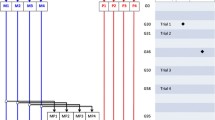Abstract
Mating propensity and fertility were studied in five laboratory strains of Drosophila ananassae which were established from single females collected from different geographical localities. The results show statistically significant variation among different isofemale lines with respect to mating propensity and fertility. The strains showing greater sexual activity produce more progeny. Thus, there is a positive correlation between mating activity and fertility in D. ananassae. The comparison of mating frequencies of strains and their hybrids reveals the existence of heterosis and reciprocal effects. The data suggest that the males are more subject to intrasexual selection.
Similar content being viewed by others
References
Bastock, M., 1956. A gene mutation that changes a behaviour pattern. Evolution 10: 421–439.
Bateman, A. J., 1948. Intra-sexual selection in Drosophila. Heredity 2: 349–368.
Bösiger, E., 1960. Sur le rôle de la sélection sexuelle dans l'évolution. Experientia 16: 270–273.
Elens, A. A., 1957. Importance séléctive des différences d'activité entre mâles ebony et sauvage, dans les populations artificielles de Drosophila melanogaster. Experientia 13: 293–294.
Fulker, D. W., 1966. Mating speed in male Drosophila melanogaster: A psychogenetic analysis. Science 153: 203–205.
Gilbert, D. G. & Richmond, R. C., 1982. Esterase 6 in Drosophila melanogaster: Reproductive function of active and null males at low temperature. Proc. natn. Acad. Sci. U.S.A. 79: 2962–2966.
Kessler, S., 1968. The genetics of Drosophila mating behaviour 1. Organization of mating speed in Drosophila pseudoobscura. Anim. Behav. 16: 485–491.
Manning, A., 1961. The effects of artificial selection for mating speed in Drosophila melanogaster. Anim. Behav. 9: 82–92.
Maynard Smith, J., 1956. Fertility, mating behaviour, and sexual selection in Drosophila subobscura. J. Genet. 54: 261–279.
Merrell, D. J., 1949. Selective mating in Drosophila melanogaster. Genetics 34: 370–389.
Parsons, P.A., 1964. A diallele cross for mating speeds in Drosophila melanogaster. Genetica 35: 141–151.
Parsons, P. A., 1965. The determination of mating speeds in Drosophila melanogaster for various combinations of inbred lines. Experientia 21: 478.
Parsons, P. A., 1973. Behavioural and ecological genetics: A study in Drosophila. Clarendon Press, Oxford.
Petit, C., 1951. Le rôle de l'isolement sexuel dans l'évolution des populations de Drosophila melanogaster. Bull. biol. 85: 392–418.
Prakash, S., 1967. Association between mating speed and fertility in Drosophila robusta. Genetics 57: 655–663.
Reed, S. C. & Reed, E. W., 1950. Natural selection in laboratory populations of Drosophila II. Competition between a white eye gene and its wild type allele. Evolution 4: 34–42.
Sharp, P. M., 1984. The effect of inbreeding on competitive male mating ability in Drosophila melanogaster. Genetics 106: 601–612.
Singh, B. N. & Chatterjec, S., 1985. Symmetrical and asymmetrical sexual isolation among laboratory strains of Drosophila ananassae. Can. J. Genet. Cytol. 27: 405–409.
Singh, B. N. & Chatterjee, S., 1986. Mating ability of homo- and heterokaryotypes in Drosophila ananassae. Heredity 57: 75–78.
Singh, B. N., Chatterjee, S. & Roy, S., 1985. Behavioural analysis of mating between white-eyed and wild-type Drosophila ananassae. Ind. J. exp. Biol. 23: 661–662.
Spiess, E. B., 1970. Mating propensity and its genetic basis in Drosophila, pp. 315–379. In: M. K. Hecht and W. C. Steere (eds). Essays in evolution and genetics in honour of Theodosius Dobzhansky. Appleton Century Crofts, New York.
Spiess, E. B. & Langer, B., 1961. Chromosomal adaptive polymorphism in Drosophila persimilis III. Mating propensity of homokaryotypes. Evolution 15: 535–544.
Spieth, H. T., 1952. Mating behaviour within the genus Drosophila (Diptera). Bull. Amer. Mus. Natural Hist. 99: 395–474.
Sturtevant, A. H., 1915. Expetiments on sex recognition and the problem of sexual selection in Drosophila. J. Anim. Behav. 5: 351–366.
Author information
Authors and Affiliations
Rights and permissions
About this article
Cite this article
Singh, B.N., Chatterjee, S. Variation in mating propensity and fertility in isofemale strains of Drosophila ananassae . Genetica 73, 237–242 (1987). https://doi.org/10.1007/BF00055279
Received:
Accepted:
Issue Date:
DOI: https://doi.org/10.1007/BF00055279




